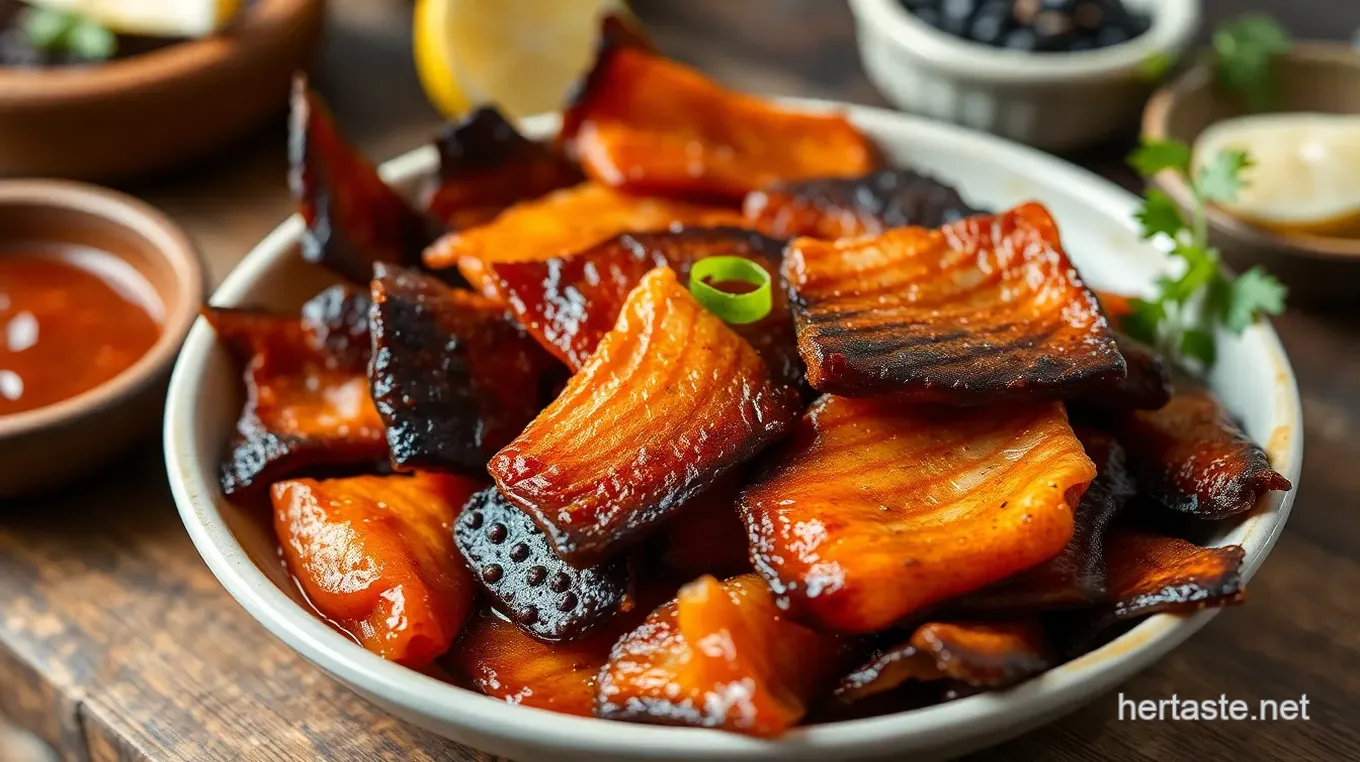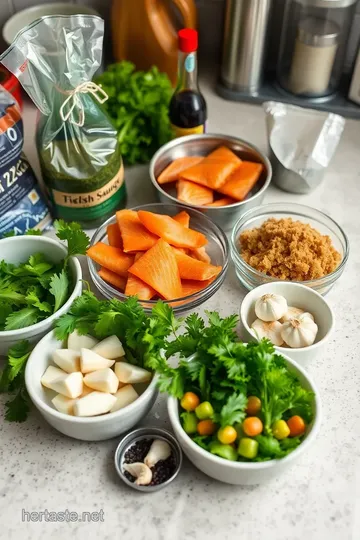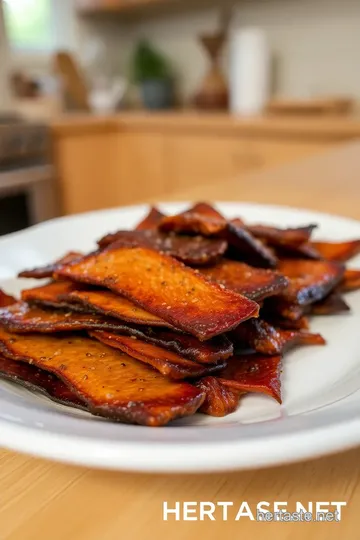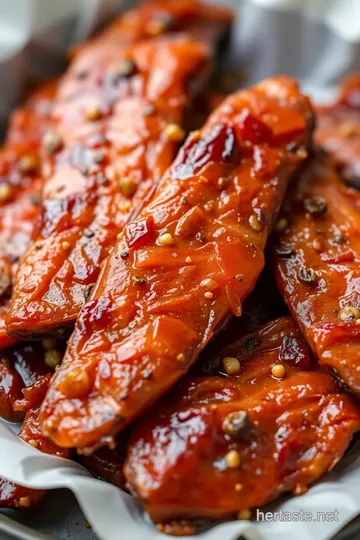Delightfully Easy Dehydrated Fatty Fish Jerky
Craving a healthy snack? Let me guide you through my delightfully easy way to dehydrate fatty fish jerky! It's scrumptious, protein-packed, and perfect for any adventure!

- look into into the Delight of Fish Jerky
- Essential Ingredients Guide for Dehydrating Fish Jerky
- Dehydrate Fatty Fish Jerky Delightfully Easy
- Pro Tips & Secrets for Dehydrate Fatty Fish Jerky Delightfully Easy
- Perfect Presentation: Making Your Jerky Shine
- Storage & Make-Ahead: Keeping That Jerky Fresh
- Creative Variations: Get Wild with Your Jerky!
- Complete Nutrition Guide: Snacking Smart
- Expert FAQ Solutions: Your Jerky Questions Answered
- Encouragement to Get Started
- Recipe Card
look into into the Delight of Fish Jerky
Oh my gosh! have you ever had that moment where you’re craving something delicious yet healthy to munch on? that was me a few weekends ago.
Picture this: i'm on a hike, the sun shining, lungs filled with that fresh mountain air, but my snack options were.
.. let’s just say, disappointing. i thought about how i could avoid another boring energy bar. and that’s when the idea hit me— dehydrate fatty fish jerky delightfully easy .
I mean, what could be better than savory, protein-packed fish jerky for outdoor snacking? let’s dive into this delicious adventure together!
From Sea to Snack: The Journey of Fish Jerky
Fish jerky isn't just some trendy snack; it has roots that dive deep into history. indigenous peoples have been drying fish for centuries, making it a staple for preserving food.
Nowadays, it's taking on a modern twist. thanks to folks wanting healthier snacking options, fish jerky is making waves in the snack aisle and in our kitchens!
You can whip this up in about five hours , with only 15 minutes of active prep time . super easy, right? plus, it serves about four portions, so you can share—or not, i won’t judge if you want to keep it all to yourself! when it comes to cost, it's quite wallet-friendly too, especially when you compare it to those overpriced store-bought gourmet fish jerky bags.
The Sweet Side of Savory: Health Benefits Galore
What’s really cool about dehydrated fish recipes is they bring tons of health benefits to your table—or your hiking pack! fatty fish like salmon and mackerel come loaded with omega-3 fatty acids.
Seriously, these little gems are known to support brain health, promote heart health, and even boost your mood.
And let’s not forget – this homemade jerky is a solid protein-rich snack . whether you’re a busy athlete or just someone looking for a yummy pick-me-up, this jerky's got your back.
Plus, you can play around with flavors. how about a spicy twist or maybe a smoky kick? trust me, it’s all in your jerky marinade variations .
Perfect for Any Occasion
Now, when should you serve this delight? honestly, the possibilities are endless. it’s perfect for those outdoor adventures, game nights, or just as a healthy snack idea while binge-watching your favorite series.
Think about it... who wouldn’t grab a bite of savory fish snacks while watching the big game?
And here’s a pro tip: you can also impress your friends at gatherings with this easy jerky. just whip it up ahead of time, and when your guests arrive, they’ll wonder how you got so gourmet.
You'll look like a total kitchen genius while enjoying all the compliments!
Alright, now that we've established why you absolutely need this recipe in your life, let’s gather our ingredients and get started! trust me, you won’t regret making this delight for your next adventure or snack attack.
You’re gonna love how simple this is. stay tuned for the next section because we’re about to unlock the secrets of the perfect fish jerky.
You'll be snacking on flavorful fish bites in no time! ready? let's get cooking!

Essential Ingredients Guide for Dehydrating Fish Jerky
When it comes to making your own delightfully easy dehydrated fatty fish jerky , the ingredients are where it all begins.
Trust me, getting the right quality and combination really pays off! let’s break it down into some handy categories so you can feel confident and excited about whipping up your own homemade jerky .
Premium Core Components
First off, let’s talk measurements . You’ll need about 1 lb (450 g) of fatty fish like salmon or mackerel. If you’re like me and still trying to wrap your head around the metric system, don’t sweat it— 1 lb is just a standard store package!
Speaking of quality, look for fish that’s fresh and bright. key indicators ? it should smell like the ocean, not fishy! for the marinade, trust your gut but keep your soy sauce and maple syrup high-quality to really amp up those flavors.
Storage guidelines are also crucial. properly dehydrated jerky can last up to 1-2 months in an airtight container. store it in a cool, dark place like a pantry, or pop it in the fridge for extra shelf life.
Freshness tip : always label and date your containers so you don’t have a surprise snack down the road!
Signature Seasoning Blend
Moving on to the fun part—the seasonings ! for this fish jerky, you’re using a mix of soy sauce, maple syrup, apple cider vinegar, smoked paprika, garlic powder, and black pepper.
Combine these for a flavor explosion! and don’t be shy; play with herb selections too! a sprinkle of dill or even some red pepper flakes can take your jerky to new heights.
Flavor enhancers like the maple syrup not only add sweetness but help to balance the saltiness of soy sauce, creating that perfect savory-sweet bite.
If you’re feeling adventurous, you might explore regional variations based on what herbs are popular in your area. love cajun? toss in some of that seasoning for a kick!
Smart Substitutions
Have something in your pantry that you can’t use? no worries! smart substitutions can save the day. no soy sauce? use tamari for a gluten-free alternative.
No maple syrup? honey works perfectly! those little switches make this recipe so flexible and can trim back on certain ingredients if that’s your jam.
And here’s a tip for those of y’all looking out for special diets. if you’re going low-carb, maintain the same flavor profile by eliminating any added sugars.
You can even explore using coconut aminos as a soy substitute!
Kitchen Equipment Essentials
Now, let’s get real about the tools . you’ll need a food dehydrator or an oven —that’s honestly the cornerstone of this process.
If you don’t have either, a sun dehydrator can do the trick! i remember trying to do this once in the florida sun; it was a bit too much work, but hey, creative experiments are my jam!
Having a mixing bowl , zip-top plastic bags for marinating, and a cutting board are also essentials. A baking sheet comes in handy if your oven is your go-to.
For storage solutions , definitely invest in airtight containers. I can’t stress this enough—from experience, old Tupperware just doesn’t cut it; your jerky needs love!
So now that you’re well-versed in choosing your ingredients and the nitty-gritty of the process, let’s dive into the instructions! you'll feel like a chef in no time, creating a healthy snack that’s perfect for hiking or on-the-go munching.
Grab your fish and let’s get started on that savory fish jerky !
Dehydrate Fatty Fish Jerky Delightfully Easy
Oh my gosh! if you’ve ever craved a high-protein snack that packs a punch, you’re in for a treat today.
We’re diving into the world of dehydrated fish recipes , particularly the delightfully easy dehydrated fatty fish jerky . this simple yet delicious recipe turns fatty fish like salmon or mackerel into a flavorful jerky that’s perfect for hikes, road trips, or even a quick snack at home.
You can indulge yourself in a savory bite that’s protein-packed and vibrant!
Essential Preparation Steps
First things first: mise en place . sounds fancy, right? it just means having everything in its place before you start cooking.
Gather your ingredients: soy sauce, maple syrup, apple cider vinegar, and those gorgeous fish fillets. trust me, a little prep work goes a long way!
Now, let's talk about time management . the active prep time is only about 15 minutes , plus 30 minutes of marinating .
You'll also need about 4- 6 hours for dehydration. plan accordingly, so you aren’t left just staring at your fish for hours!
Organization strategies? Keep your workspace tidy! Lay out your tools: dehydrator or oven, mixing bowl, and cutting board. This way, you can breeze through the recipe without feeling stressed.
And lastly, safety considerations . Always wash your hands after handling raw fish, and keep everything clean. This is super important for food safety.
Step-by-Step Process
Time to roll up those sleeves! Here’s the plan in clear, simple steps:
-
Prepare the marinade: mix 1/4 cup soy sauce, 2 tablespoons maple syrup, 1 tablespoon apple cider vinegar in a bowl.
Add 1 teaspoon smoked paprika, 1/2 teaspoon garlic powder, and 1/2 teaspoon black pepper .
-
Marinate the fish: toss your fish strips (about 1 lb ) into a zip-top bag with that marinade. seal it up, give it a good shake, and refrigerate for at least 30 minutes .
If you can wait overnight, even better for a robust flavor!
-
Prepare for Dehydration: After marinating, remove the fish and pat it dry. This helps our jerky turn out perfectly chewy but not overly wet.
-
Dehydrate the fish: lay the fish strips in a single layer in your dehydrator set to 145° f ( 63° c) .
If you're using an oven, set it to the lowest temperature and crack the door open a bit. this step will typically take 4- 6 hours .
Keep an eye on them; they should be dry but not crumbly.
-
Cool and Store: Once it’s done, let your jerky cool completely before storing it in an airtight container.
Expert Techniques
While this recipe is a breeze, a few expert techniques can elevate your homemade jerky game. For one, make sure all fish pieces are uniform in size for even drying.
Check for quality checkpoints : if your jerky feels too brittle, it likely needs a bit more moisture. how do you know when it’s done? it should be chewy and have a nice flexibility.
And for troubleshooting, remember: if the fish smells funky before cooking, toss it out. safety first!
Success Strategies
Here are some hot tips to ensure you make the best flavorful fish snacks possible:
- Avoid common mistakes : Don’t skip the drying step; undercooked fish can lead to spoilage.
- Quality assurance : Always taste a piece before declaring it done. Seasonings can be adjusted, and who doesn’t love a good taste test?
- Want to plan ahead? Make your jerky in bulk! It’s a perfect healthy snack idea for busy days.
- look into into jerky marinade variations : Feel free to play with your spices. A sprinkle of chili powder adds a delightful kick, or toss in some herbs like dill for a fresh twist.
As you craft your gourmet fish jerky , you’ll marvel at how versatile this snack can be. it’s great for outdoor snacking options, packing protein for a camping trip, or just binge-watching your favorite series.
Feeling inspired? Let’s move on to the final notes and some additional information about the nutritional benefits of jerky and why it’s a fantastic option for athletes or anyone looking to boost their protein intake!

Pro Tips & Secrets for Dehydrate Fatty Fish Jerky Delightfully Easy
Alright, let’s dive right into the dehydrate fatty fish jerky delightfully easy recipe. if you’re anything like me, you want tips and tricks to make things even better in the kitchen.
When i first made this fish jerky, i learned a lot from trial and error. here are some pro tips to get that perfect batch:
Chef's insights: first off, use fresh fish for the best flavor. i can’t stress this enough! it makes a big difference.
I've tried frozen, and i swear the results weren’t as good. also, marinating overnight? yes, please! the longer you let that fish soak in the delicious marinade, the better.
Time-saving techniques: if you're pressed for time, don't sweat it! you can marinate the fish in the morning, then pop it in the dehydrator before you head out for the day.
Come home to a delightful aroma that’ll have your taste buds tingling!
Flavor enhancement: you can jazz up your jerky with different seasonings. ever tried dill or oregano in your marinade? just a hint of herbs elevates the flavor.
And if you like a kick, toss in some red pepper flakes. trust me, your snack game will thank you!
Presentation advice: presentation might not seem like a big deal with jerky, but hear me out! when i serve it at get-togethers, i like to arrange pieces on a colorful platter with fresh fruits.
It makes it pop—and if you want to be fancy, sprinkle a few herbs on top for that extra chef vibe!
Perfect Presentation: Making Your Jerky Shine
When it comes to plating that homemade jerky , it’s all about making it look appetizing. I learned a few nifty tricks that you can easily use.
Plating Techniques
Try stacking the jerky pieces in a slight pyramid. It creates height and looks fancy, like you’re hosting a gourmet tasting instead of just snacking.
Garnish Ideas
Fresh herbs like parsley or even a sprinkle of sesame seeds can be a charming touch. A little green goes a long way!
Color Combinations
Pair your jerky with bright fruits—think apple slices or colorful berries for that vibrant plate.
Visual Appeal Tips
Remember, we eat with our eyes first! A well-presented snack will have folks diving in right away.
Storage & Make-Ahead: Keeping That Jerky Fresh
So you've made your DIY fish jerky . Now what?
Storage Guidelines
Store your jerky in an airtight container. I use glass jars, but those zip-top bags work well, too. Date them! It’ll help you keep track of when you made it.
Preservation Methods
You can keep it in a cool, dark place if you’re eating it soon. For longer storage, toss it in the fridge—just in case!
Reheating Instructions
No need to reheat jerky, but if you're into warm snacks, a quick zap in the microwave for 10 seconds can do the trick. Just don’t overdo it!
Freshness Duration
If stored properly, your jerky can last a month or more. But honestly? It rarely sticks around that long in my house .
Creative Variations: Get Wild with Your Jerky!
Let’s be real, variety is the spice of life—especially in the kitchen!
Flavor Adaptations
Play with flavor! Instead of soy sauce, try a teriyaki sauce for a sweeter spin. Marvelous mackerel jerky has also become a favorite in my house.
Dietary Modifications
Gluten-free? No problem. Use tamari instead of soy sauce.
Seasonal Twists
In summer, add a splash of citrus to brighten things up— lemon or lime juice can work wonders!
Regional Variations
How about a southwestern spin? Toss in some chipotle for a smoky flavor. It’s incredible!
Complete Nutrition Guide: Snacking Smart
If you’re curious about the nutrition aspect (who isn’t?), here’s a quick breakdown of the nutritional benefits of jerky .
Detailed Breakdown
Just one serving gives you about 20g of protein. This is a great way to power up for your active lifestyle.
Health Benefits
Fatty fish like salmon come packed with Omega-3s, which are amazing for your heart.
Dietary Considerations
Low-carb? This jerky fits right in your meal plan. But always check the sodium level if you're watching that.
Portion Guidance
Unless you’re hiking, I find two ounces is more than enough for a snack. It’s easy to get carried away with jerky, though!
Expert FAQ Solutions: Your Jerky Questions Answered
Got questions? I’ve got answers!
Common Questions
“Can I dehydrate fish in my oven?” Oh, for sure! Just keep that temperature super low and watch it closely.
Troubleshooting Guide
If your jerky still seems chewy after dehydrating, just pop it back in. A little extra drying time won't hurt!
Success Tips
Keep your fish pieces uniform in size. This helps them dry evenly. Nobody wants a chewy piece and a crispy one!
Variations Explained
Feeling adventurous? Use different fish like trout or tuna. Each brings its own unique flavor.
Encouragement to Get Started
So there you have it! With these tips and tricks for Dehydrate Fatty Fish Jerky Delightfully Easy , you’re ready to take your jerky game to the next level.
Just remember, have fun and experiment . cooking is all about enjoying the process and finding what works for you . whether you’re munching on this as a healthy snack or taking it with you on your outdoor adventures, i promise you’ll love it.
Now, lace up those shoes and get chilling with some fish jerky! happy snacking, my friend!

Delightfully Easy Dehydrated Fatty Fish Jerky Card

⚖️ Ingredients:
- 1/4 cup soy sauce (or tamari for gluten-free)
- 2 tablespoons maple syrup
- 1 tablespoon apple cider vinegar
- 1 teaspoon smoked paprika
- 1/2 teaspoon garlic powder
- 1/2 teaspoon black pepper
- 1 lb fatty fish (like salmon or mackerel), skin removed, cut into 1/4-inch thick strips
🥄 Instructions:
- Step 1: In a mixing bowl, combine soy sauce, maple syrup, apple cider vinegar, smoked paprika, garlic powder, and black pepper.
- Step 2: Place fish strips in a zip-top bag or container, pour marinade over, ensuring all pieces are coated. Seal and refrigerate for at least 30 minutes, or up to overnight for stronger flavor.
- Step 3: Remove fish from marinade and pat dry with paper towels.
- Step 4: Arrange fish strips in a single layer in the dehydrator trays or on a baking sheet lined with parchment paper. Dehydrate at 145°F (63°C) for 4-6 hours, or until fish is dry and chewy but not brittle.
- Step 5: Once dehydrated, allow jerky to cool completely before storing in an airtight container.
Previous Recipe: How to Make Mom's Churned Pandan Ice Cream Delight: A Sweet Escape
Next Recipe: How to Sear Chicken with Savory Herbs & Zesty Flavor: A Delicious Journey
